JAIPUR
.
Attractions & Places To Visit And Explore In Jaipur
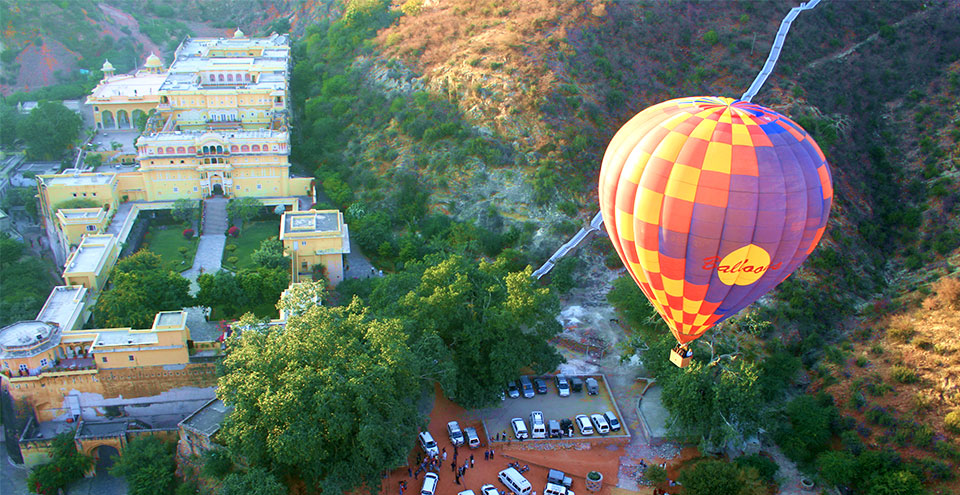
Samode is located 40kms northwest of Jaipur on Jaipur-Sikar road. The beautiful 475 year old Samode Palace provides a fine example of the Rajput haveli architecture while Samode Bagh offers luxurious tent accommodation. Visitors can experience the rural lifestyle by taking a camel safari through the village and visit local craftsmen.


Amber (pronounced Amer) is at a distance of about 11 kilometres from Jaipur. Now a UNESCO World Heritage Site, it was the bastion of the Kachwahas of Amber, until the capital was moved to the plains, to what is today Jaipur. The palace, located in craggy hills, is a beautiful melange of Hindu and Mughal styles. Raja Man Singh I began construction in 1592 and the palace, which was built as a strong, safe haven against attacking enemies, was completed by Mirja Raja Jai Singh. The contrast between the harsh exterior and the inviting interior couldn’t be more surprising. Made entirely of red sandstone and white marble, visitors are left spellbound by the magnificence of the palace that utilises carvings, precious stones and mirrors. The splendour of the palace is enhanced by the breath-taking vista of the Maota Lake in front. The palace is nearly seven centuries old and has a legendary past. Originally a small structure that the Rajputs won from the Meena tribes, it was later transformed into the grand Amber Palace.

Located deep within the walled city, the City Palace Complex was conceived and built by Maharaja Sawai Jai Singh II, the founder of Jaipur. A beautiful fusion of Mughal and Rajput architecture, the palace is still home to the last ruling royal family which lives in a private section of the palace. Maharaja Sawai Jai Singh II is credited with building most of the structures, but it was expanded upon by later rulers as well. The City Palace Complex includes the Mubarak Mahal (the palace of reception) and the Maharani’s Palace (the palace of the queen). Mubarak Mahal now houses the Maharaja Sawai Man Singh II Museum and displays a vast and unique collection of royal costumes, delicate Pashmina (Kashmiri) shawls, Benaras silk saris, and other dresses with Sanganeri prints and folk embroidery. The clothes of Maharaja Sawai Madho Singh I are also on display. The Maharani's Palace, surprisingly, has an interesting display of very well-preserved Rajput weaponry, some dating back to the 15th century. Other than the arms, the palace is adorned with beautiful paintings on the ceiling that are well-maintained.

Now a UNESCO World Heritage Site, Jantar Mantar in Jaipur is considered to be the largest of the five astronomical observatories built by Maharaja Sawai Jai Singh II, the founder of Jaipur. It contains sixteen geometric devices, designed to measure time, track celestial bodies and observe the orbits of the planets around the sun. It also houses the Interpretation Centre that helps the tourists to understand about the working principles & chronolgy of the observatory.

Hawa Mahal, literally the Palace of Winds, was built in 1799 by the poet king Sawai Pratap Singh as a summer retreat for him and his family. It also served as a place where the ladies of the royal household could observe everyday life without being seen themselves. This unique five-storey structure is a blend of Hindu and Islamic architecture, and the exterior, with its small latticed windows (called jharokhas), resembles the crown of Lord Krishna. The windows also serve as an air-conditioner of sorts, blowing cool air throughout the palace, making it the perfect retreat during summers. Built from pink sandstone, the Hawa Mahal is Jaipur’s iconic landmark and visitors can view its complete magnificence from outside, from across the road. However, it is also possible to climb right up to the top for a wonderful view from the windows. Today, the Mahal is maintained by the Archaeological Department of the Government of Rajasthan and also houses an archaeological museum in the courtyard.

The building gets its name from The Victoria and Albert Museum in London, the inspiration for its design. The exquisitely built Albert Hall is housed in the centre of Ram Niwas Garden. Sir Swinton Jacob (who is also the mastermind behind many other palaces in Rajasthan) conceptualised and designed it using styles from the Indo-Sarcenic architecture and the Prince of Wales laid the foundation stone of the building in 1876. The museum displays a wide range of metal objects, wood crafts, carpets, stone and metal sculptures, arms and weapons, natural stones and ivory goods. It also houses a large collection of miniatures from Bundi, Kota, Kishangarh, Udaipur and Jaipur schools of art.


About 15 kilometres from Jaipur, Jaigarh Fort was built by Sawai Jai Singh II sometime in the early 18th century amidst the arid, rocky and thorn-scrub covered hills. Despite its ancient construction, it still retains most of its imposing citadel appearance. Visitors can see the world’s largest cannon – Jaiban, at the fort.

The Lakshmi-Narayan Temple, or the Birla Temple, as it is more popularly known as, is located at the base of Moti Dungari. Built on an elevated platform, this comparatively modern temple is built entirely of white marble and dominates the skyline of south Jaipur. The temple was commissioned and built by renowned Indian industrialists, the Birlas, in 1988. The temple is dedicated to Lord Vishnu, also called Narayan, and his companion, Lakshmi, the Goddess of wealth and good fortune. The temple is a work of art and has a marvellous display of exquisite carvings and sculptures covering many mythological themes. The eye is drawn to the images of Laxmi and Narayan, carved as they are, from one piece of marble. The top of the temple has three domes, each representing the three religions followed in India. This is designed to pay homage to secular India. The temple looks spectacular at night when it is lit up. Other than the main temple, the complex has a museum that exhibits the earlier belongings of the Birla family.

One of the most wonderful sights in Jaipur is the beautiful Jal Mahal or Lake Palace. The light, sand coloured stone walls and the deep blue of the water make for a wonderful contrast. The palace appears to float in the centre of Man Sagar Lake, where its magnificent exteriors can be enjoyed by tourists.
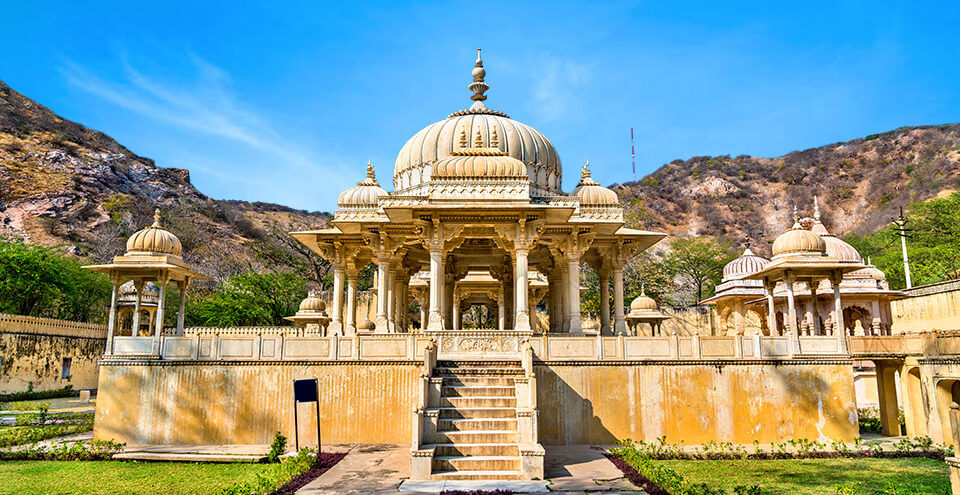
Just off the Jaipur-Amber road is Gaitore, where the former Maharajas of Jaipur are entombed. The chhatris (cenotaphs), made of white marble display the distinctive Rajput style of architecture. The open pavilions with ornate domes are supported by delicately sculpted pillars. The crematorium is located in the middle of yellow sandstone hills. The décor and extravagance of a particular chattri is meant to reflect the stature and prowess of the ruler it contains. The most graceful and beautiful chattri at Gaitor is that of Maharaja Jai Singh with 20 carved pillars. Tourists are especially drawn towards it because of its intricate carvings.

Sisodia Rani Palace and Garden is located 8 kilometres from Jaipur on the Agra road. Laid out in Mughal style, it is painted with the legends of Radha and Krishna. The garden is multi-tiered and has fountains, water courses and painted pavilions. Maharaja Sawai Jai Singh II built it for his Sisodia queen.

Located near Sisodia Garden, this is yet another beautiful garden which is a must-see for visitors. It is named after Vidyadhar Bhattacharya, the Chief Architect of Jaipur.
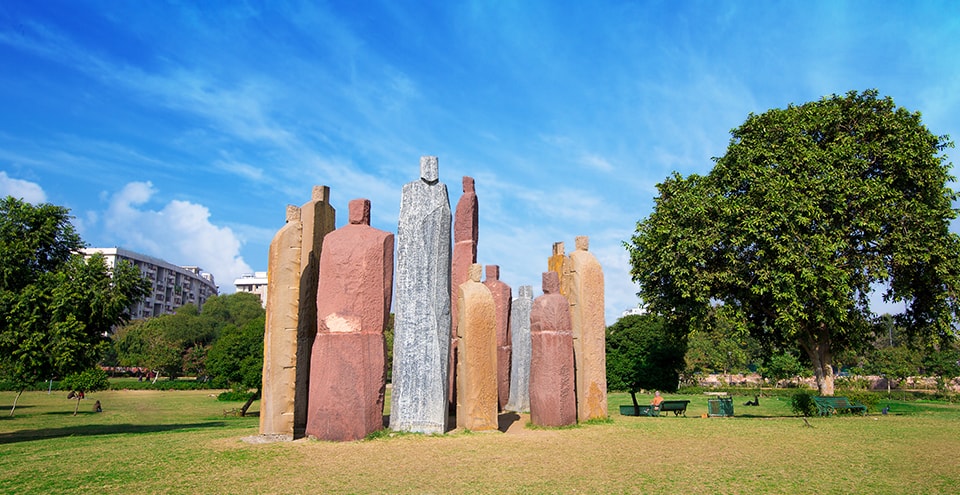
Central Park is a large green zone right in the centre of Jaipur that offers city dwellers a spot for a moment of respite. Conceptualised and built by the Jaipur Development Authority, it is Jaipur’s largest park. It houses a lush garden, the Polo Ground and a golf club. However, the highlight of the park is India’s first all-day-and-all-night monumental National Flag which also happens to be the country’s tallest flagpole.

At a mere ten-minute walk through the cobbled streets of Amber lies the Anokhi Museum of Hand Printing. Located in a magnificently restored haveli (mansion), the museum displays a varied selection of block-printed textiles alongside images, tools and related objects – all chosen to provide an in-depth look into the complexity of this ancient tradition.

Located at the foothills of Nahargarh hills on the way to Amber, Kanak Vrindavan is popular among the locals for picnics. The beautifully landscaped garden houses an intricately carved temple, several terrace sites, marble columns and lattices, making it a dream location for film shoots as well.
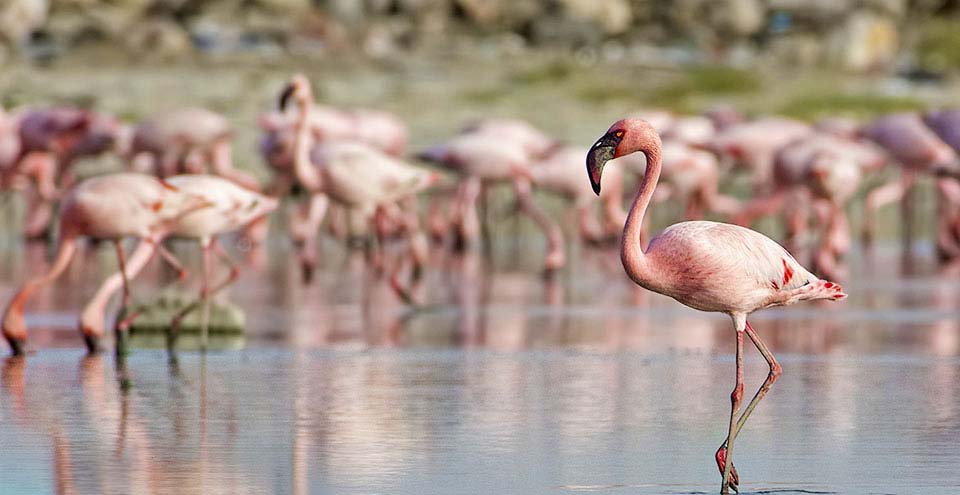
Sambhar Lake is one of the largest inland salt lake and lies just 70 kms from Jaipur. It is an incredible landscape, almost resembling the Rann of Kutch, Gujarat. Apart from producing a large percentage of India's salt supply - it also an incredible place to spot birds including large flocks of flamingos. The views from the Shakambhari Mata Temple are breathtaking at sunset and one can spend hours in solitude. Another unique aspect is the Saltwork's own railway system built to transfer salt from the pans to the processing unit. A visit to the salt lake and a walk in the Sambhar town is also a must do activity. Devyani Kund, Sharmishtha Sarovar, Salt Museum, Circuit House, etc are also important places to visit in Sambhar. One can also visit religious sites Naraina & Bhairana on the way to Sambhar.
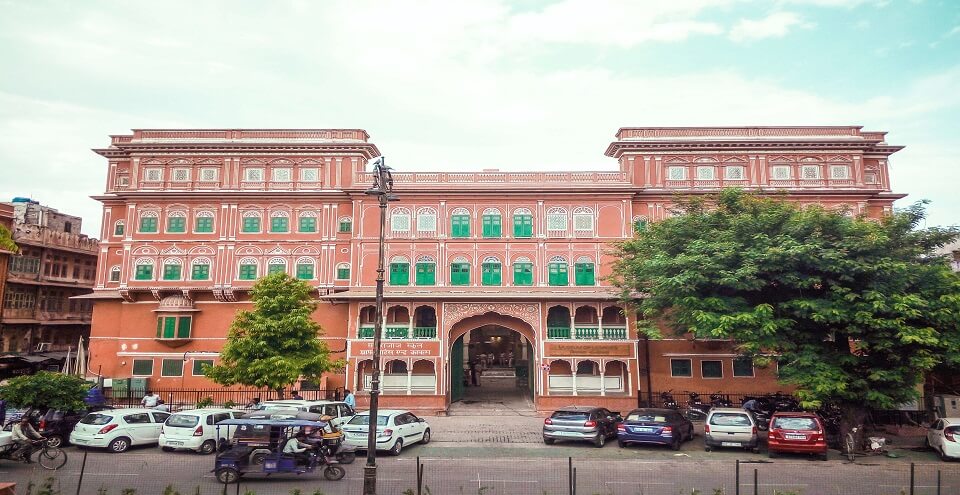
Housed in a nearly 200-year old building in the historic Kishanpole Bazaar of Jaipur's Pink City area, Museum of Legacies opened on 9 December, 2017. The aim is to create an artspace that exclusively displays the rich cultural heritage of Rajasthan, with a diverse collection that includes everything from textiles, jewellery, stoneware and inlay work, painting, pottery and more. Apart from this, indigenous art from different parts of India are also given a platform here. This is a very inclusive space that caters to locals and tourists alike. Museum of Legacies currently has with eight active galleries. Each has been allotted to an individual who has been instrumental in the art and culture scene of India. Brij Bhasin’s collection of Everyday Embroideries shows the stunning array of textiles that are found across the state of Rajasthan. Mitch Crites displays semi-precious stone and marble works that have been created in his oeuvre and paintings that have been lovingly collected by him and his wife, Nilou, during their stay in India.
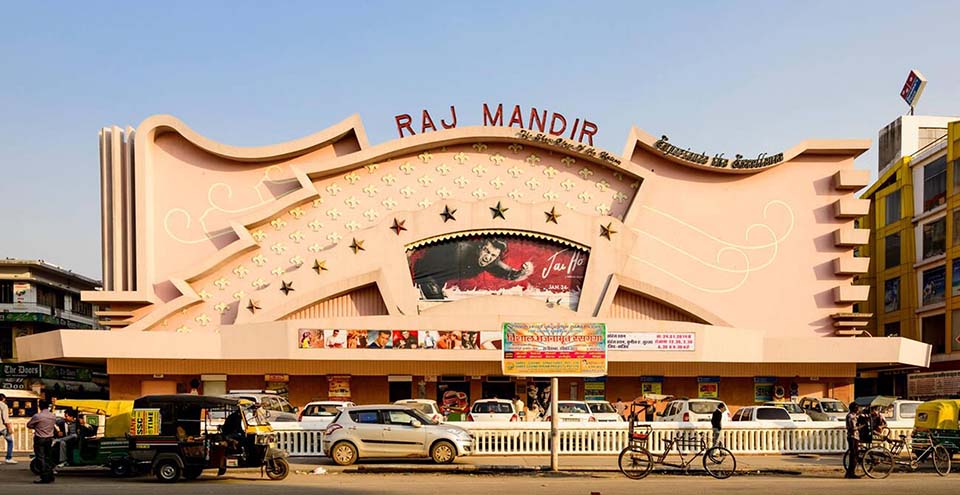
One of the most famous spots in Jaipur is the Raj Mandir Cinema. A single-screen experience, done up with a royal and luxurious architecture, the cinema holds a special place in the Pink City. Watching a Hindi movie is an amazing experience at this cinema, and booking your seat in advance is always a good idea. It was established in 1976. An asymmetrical exterior design helps the theater stand apart. Inside, the extravagantly finished roof, grand chandeliers, and a rising staircase next to the lobby lend an old world charm to the place.Located just off MI road, a Jaipur trip cannot be considered complete without a visit to the Raj Mandir.
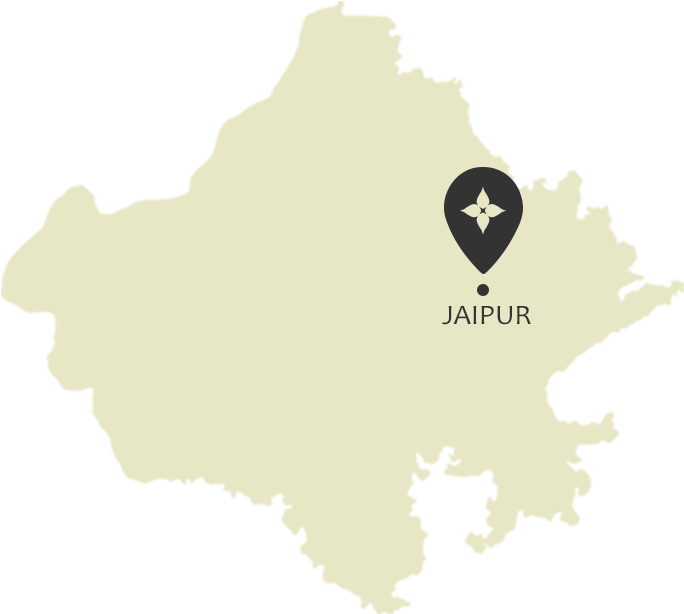
HOW TO REACH HERE
Get a price quote
For a quick query, just call us.